
In this fast-moving world, we're constantly gazing at screens which not only affects our eyes but also often leads to us having bad posture. And bad posture in itself can cause a lot of health problems such as headaches, neck and back pain, and even trouble breathing. But don't worry, there are some exercises that can help fix your posture and relieve these issues!
So, in this article, we're going to share some effective exercises that you can do from the comfort of your own home to help correct your posture. We'll be covering different types of exercises such as stretches, strengthening exercises, and mobility exercises. Apart from that, we'll also provide you with easy-to-follow instructions, as well as some tips on how to maintain good posture throughout the day by making a few lifestyle changes.
By adding these exercises to your daily routine, you'll strengthen your muscles, improve flexibility, and boost your posture. Whether you're working remotely or sitting at a desk for long hours, these exercises can really help with your health and well-being. And if you ever experience pain or discomfort, don't hesitate to reach out to a professional. With 24/7 urgent care and online doctor consultations, you can easily get expert advice to keep you on track with your health
Common Posture Problems
Many people experience common posture problems that can cause discomfort and even lead to health issues. In the following infographic, we have provided 8 common posture problems and their short description.
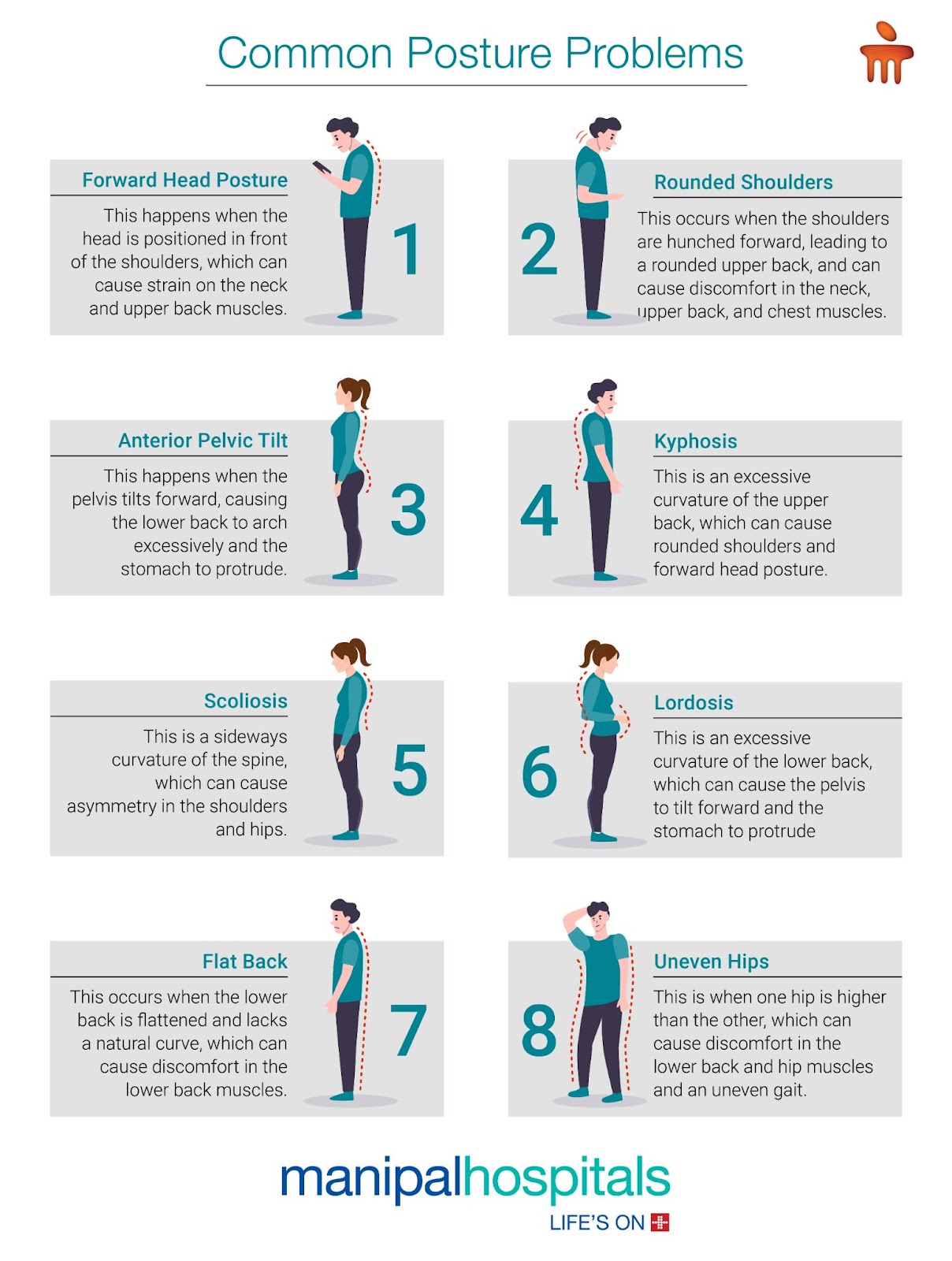
8 Best Posture Correction Exercises to Improve Your Posture and Relieve Pain
Having good posture is important for maintaining good health and overall well-being. However, many people suffer from posture problems that can cause discomfort, pain, and even lead to health issues. Thankfully, there are exercises by suggested physical therapist in Bangalore that can help improve posture and reduce pain. Here we have discussed 8 of the best posture correction exercises recommended by experts. These exercises are easy to perform and require little to no equipment, so you can do them in the comfort of your own home. By incorporating these exercises into your routine, you can improve your posture, reduce pain, and feel more confident in your daily life.
-
Shoulder Blade Squeeze
The shoulder blade squeeze is a simple exercise that can help improve posture by strengthening the muscles in the upper back and shoulders. This exercise involves squeezing the shoulder blades together and holding the position for a few seconds before releasing. It's a great exercise for anyone who spends a lot of time sitting or working at a desk.

How to do shoulder Blade Squeeze Exercise?
Here's a step-by-step guide to do the shoulder blade squeeze exercise:
-
Begin by sitting or standing with your back straight and your arms by your sides.
-
Gently draw your shoulder blades back and down, squeezing them together.
-
Hold this position for 5-10 seconds while keeping your back straight and your shoulders relaxed.
-
Release the squeeze and allow your shoulders to relax back to their starting position.
-
Repeat this exercise for 2-3 sets of 10-15 repetitions, taking a short break between each set.
Precautions: Focus on squeezing your shoulder blades together without hunching your shoulders or tensing your neck.
-
Chin Tuck
The chin tuck is a simple exercise that can help correct posture and alleviate neck pain. This exercise involves gently tucking the chin inwards towards the neck, which can help improve the alignment of the head and neck. It's a great exercise for anyone who spends a lot of time looking down at a computer or phone screen.
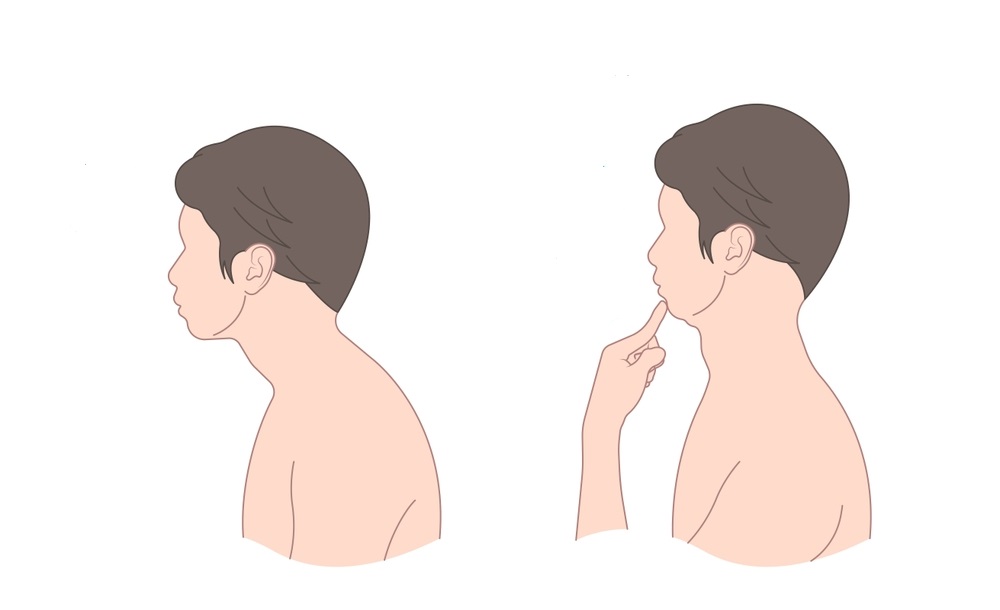
How to do Chin Tuck Exercise?
Follow the steps below to do chin tuck exercise:
-
Begin by sitting or standing with your back straight and your shoulders relaxed.
-
Look straight ahead and imagine a string attached to the top of your head, gently pulling your head upwards.
-
Slowly tuck your chin inwards towards your neck, while keeping your eyes looking straight ahead.
-
Hold this position for 5-10 seconds, while feeling a gentle stretch at the base of your neck.
-
Release the tuck and return your head to its starting position.
-
Repeat this exercise for 2-3 sets of 10-15 repetitions, taking a short break between each set.
Precautions: Avoid tilting your head up or down while doing this exercise, and keep your shoulders relaxed throughout.
-
Chest Stretch
The chest stretch is a simple exercise that can help improve posture by stretching the muscles in the chest and shoulders. This exercise involves raising your arms to shoulder height and squeezing your shoulder blades together while keeping your chest open. It's a great exercise for anyone who spends a lot of time sitting or hunched over a desk.
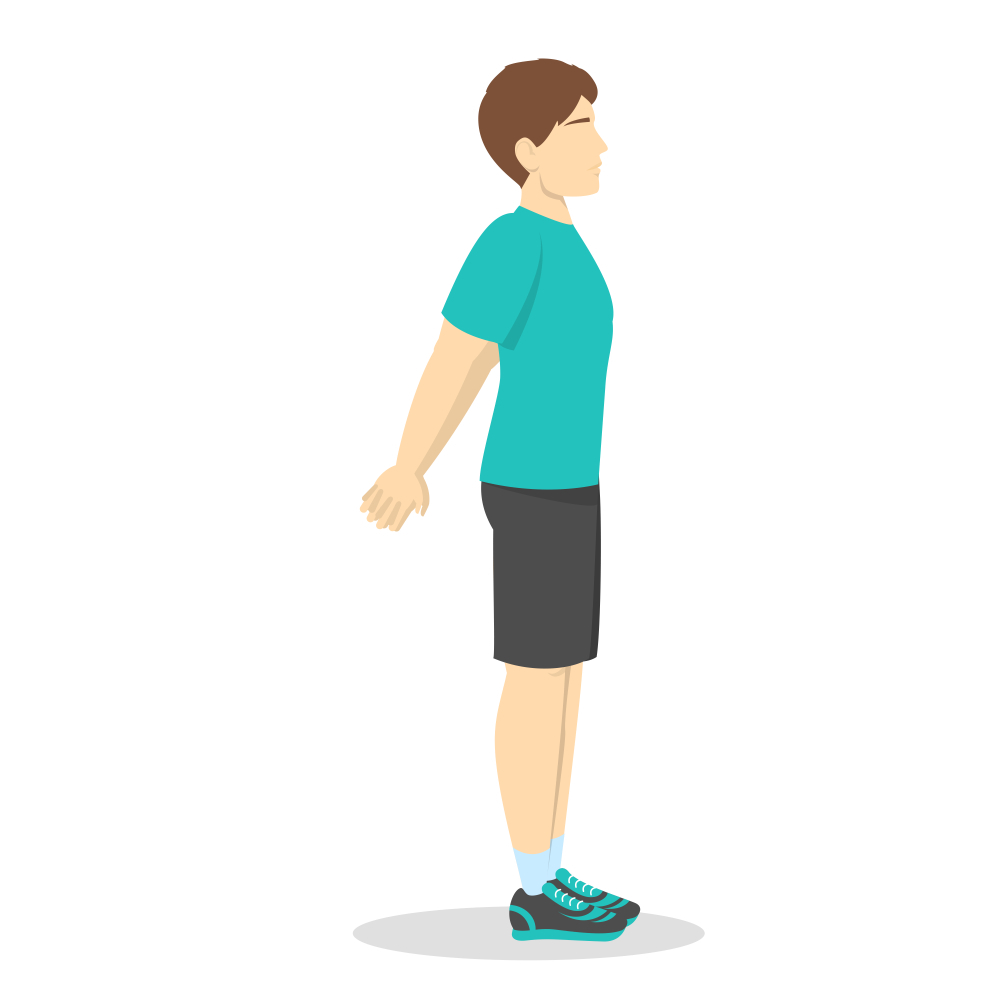
How to do chest stretch exercise?
The step-by-step process to do chest stretch exercise is provided below:
-
Begin by standing up straight with your feet shoulder-width apart.
-
Interlace your fingers behind your back and straighten your arms.
-
Squeeze your shoulder blades together and lift your arms up and away from your body.
-
Keep your chest open and your shoulders relaxed.
-
Hold the stretch for 15-30 seconds while taking deep breaths.
-
Release the stretch and return your arms to your sides.
-
Repeat this exercise for 2-3 sets of 10-15 repetitions, taking a short break between each set.
Precautions: Keep your shoulders relaxed throughout the stretch and avoid arching your back.
-
Cat-Cow Stretch
The cat-cow stretch is a yoga-inspired exercise that can help improve posture by increasing flexibility and mobility in the spine. This exercise involves moving through two poses - the cat pose and the cow pose - in a flowing motion. It's a great exercise for anyone who wants to improve their spinal health and reduce tension in the back.
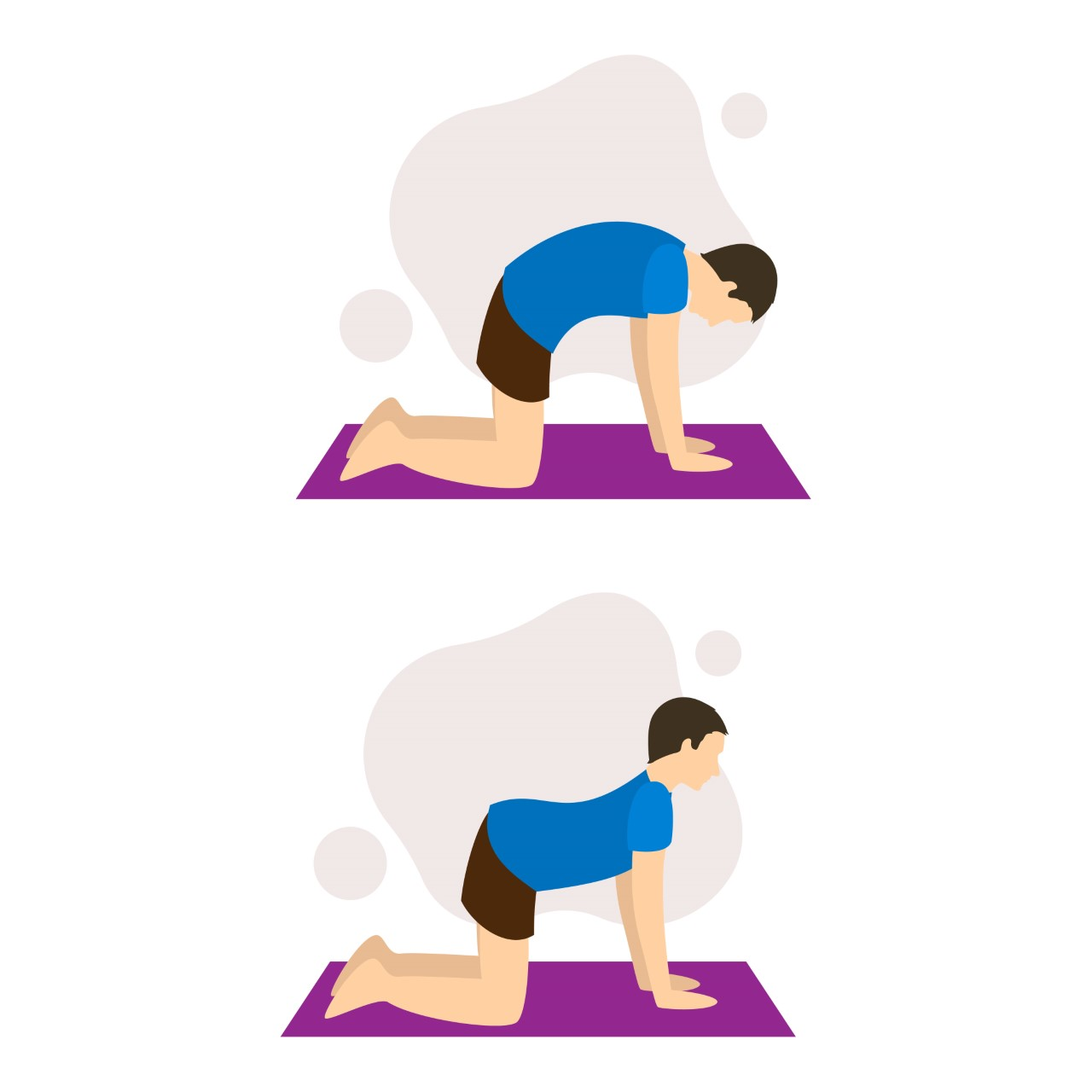
How to do Cat-Cow Stretch Exercise?
Here's a step-by-step guide on how to do the cat-cow stretch exercise:
-
Begin on your hands and knees with your wrists directly under your shoulders and your knees directly under your hips.
-
As you inhale, lift your tailbone up towards the ceiling, arch your back, and let your head hang down towards the floor - this is the cow pose.
-
As you exhale, tuck your chin to your chest, round your spine towards the ceiling, and bring your belly button towards your spine - this is the cat pose.
-
Continue moving between the cow pose and the cat pose, inhaling as you move into the cow pose and exhaling as you move into the cat pose.
-
Repeat this exercise for 2-3 sets of 10-15 repetitions, taking a short break between each set.
Precautions: Move slowly and smoothly between the two poses, and avoid forcing your body into any uncomfortable positions.
-
Plank
The plank is a popular exercise that can help improve posture by strengthening the core muscles, which support the spine and keep the body in proper alignment. This exercise involves holding a static, straight body position while engaging the muscles of the abdomen, back, and shoulders. It's a great exercise for anyone who wants to improve their overall posture and core strength.
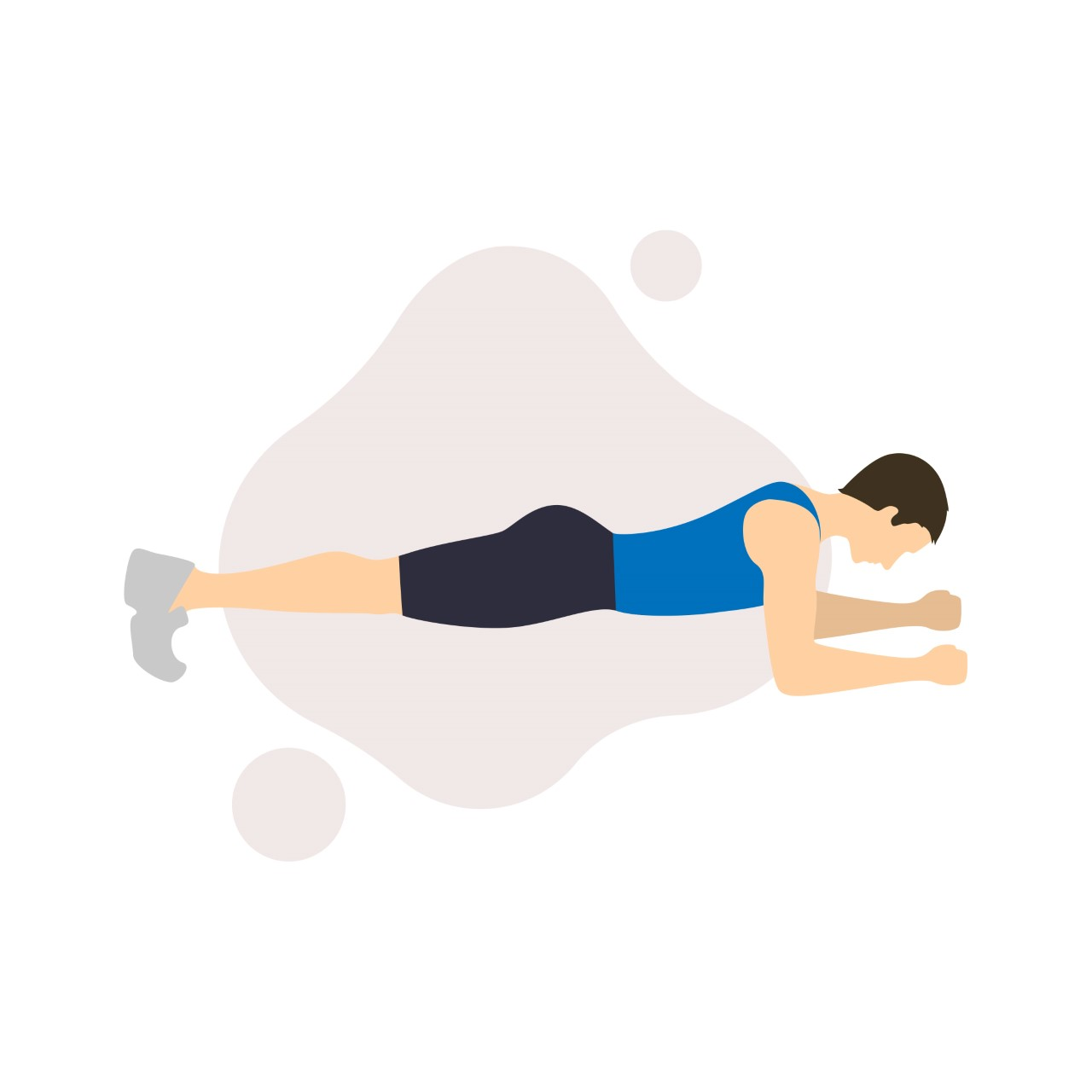
How to do plank exercise?
Follow the steps below to do plank exercise:
-
Begin in a push-up position with your hands shoulder-width apart, and your toes tucked under.
-
Engage your core and glutes to keep your body in a straight line from your head to your heels.
-
Keep your neck and spine in a neutral position by looking down at the floor.
-
Hold the position for 30 seconds to 1 minute, or as long as you can maintain good form.
-
As you progress, try to hold the position for longer periods of time or add variations, such as lifting one leg or arm off the ground.
-
Repeat this exercise for 2-3 sets of 10-15 repetitions, taking a short break between each set.
Precautions: Keep your body in a straight line and avoid letting your hips sag or pike upwards.
-
Glute Bridge
The glute bridge is a simple exercise that can help improve posture by strengthening the muscles in the lower back, glutes, and hips. This exercise involves lifting the hips off the ground while squeezing the glutes, and can be modified to suit different fitness levels. It's a great exercise for anyone looking to improve their posture and core stability.

How to do glute bridge exercise?
-
Lie flat on your back with your arms at your sides, knees bent, and feet flat on the ground.
-
Engage your core and glutes, and push your hips up towards the ceiling, keeping your shoulders and feet flat on the ground.
-
Hold the position for 1-2 seconds, squeezing your glutes at the top of the movement.
-
Slowly lower your hips back down to the starting position.
-
Repeat for 2-3 sets of 10-15 repetitions.
Precautions: Make sure to keep your feet flat on the ground throughout the exercise, and avoid pushing up onto your toes. Keep your core engaged and avoid arching your lower back as you lift your hips.
-
Wall Angels
Wall angels are a simple and effective exercise for improving posture and reducing upper back pain. This exercise involves standing with your back against a wall and moving your arms up and down in a "snow angel" motion. It's a great exercise for anyone who spends a lot of time sitting or hunching over a desk.
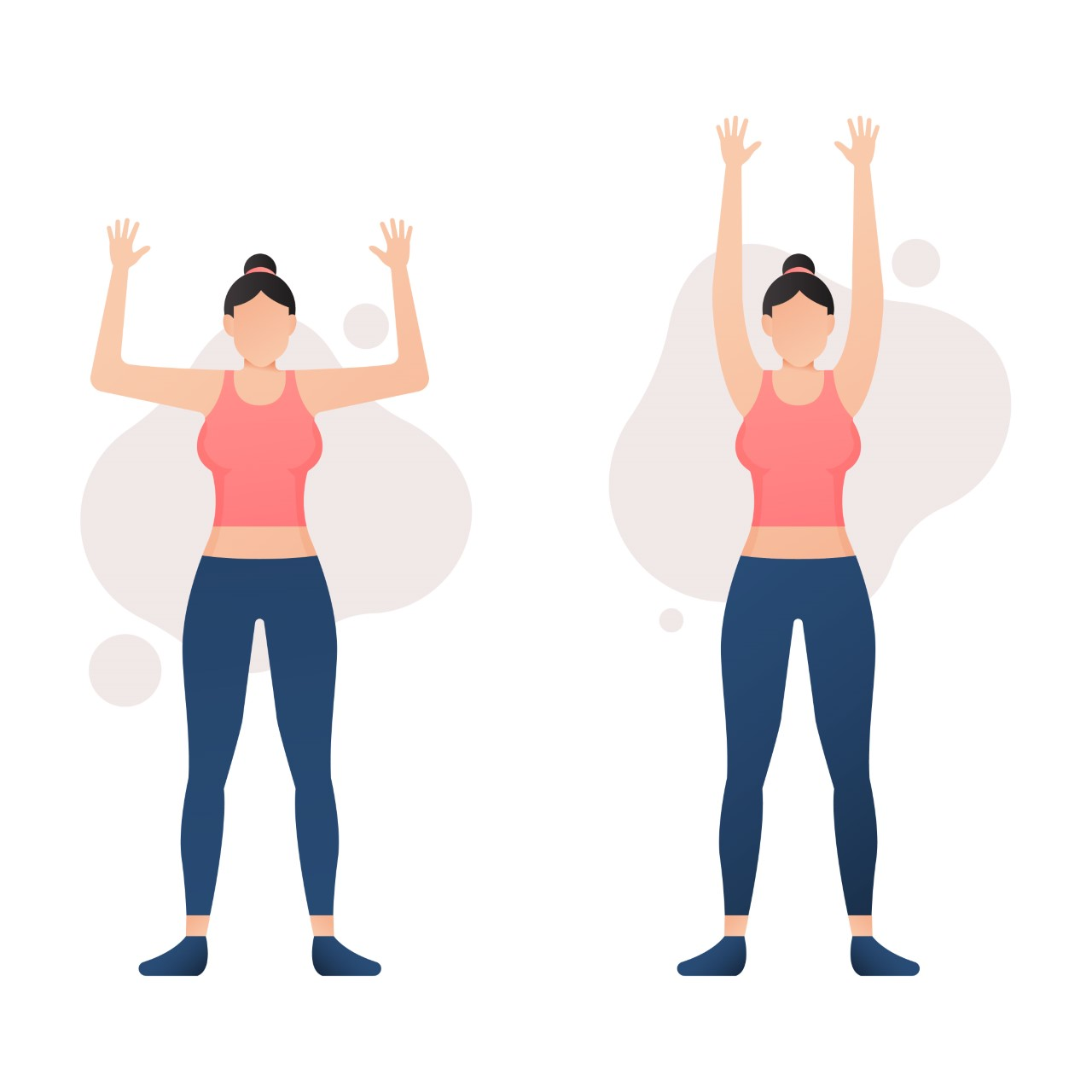
How to do wall angels exercise?
The step-by-step process to do chest stretch exercise is provided below:
-
Stand with your back against a flat wall, with your feet about 6 inches away from the wall and your knees slightly bent.
-
Bring your arms up to shoulder level, with your elbows bent at a 90-degree angle and your hands resting against the wall.
-
Slowly move your arms up and down in a "snow angel" motion, keeping your hands and elbows in contact with the wall at all times.
-
Make sure to keep your shoulders relaxed and your back flat against the wall throughout the exercise.
-
Repeat for 2-3 sets of 10-15 repetitions.
Precautions: Make sure to use slow, controlled movements and focus on keeping good form throughout the exercise.
-
Seated Twist
The seated twist is a simple yet effective exercise for improving spinal mobility and reducing tension in the back and neck. This exercise involves sitting on the floor with your legs crossed and twisting your torso to each side. It's a great exercise for anyone who spends a lot of time sitting or has tightness in the back and hips.
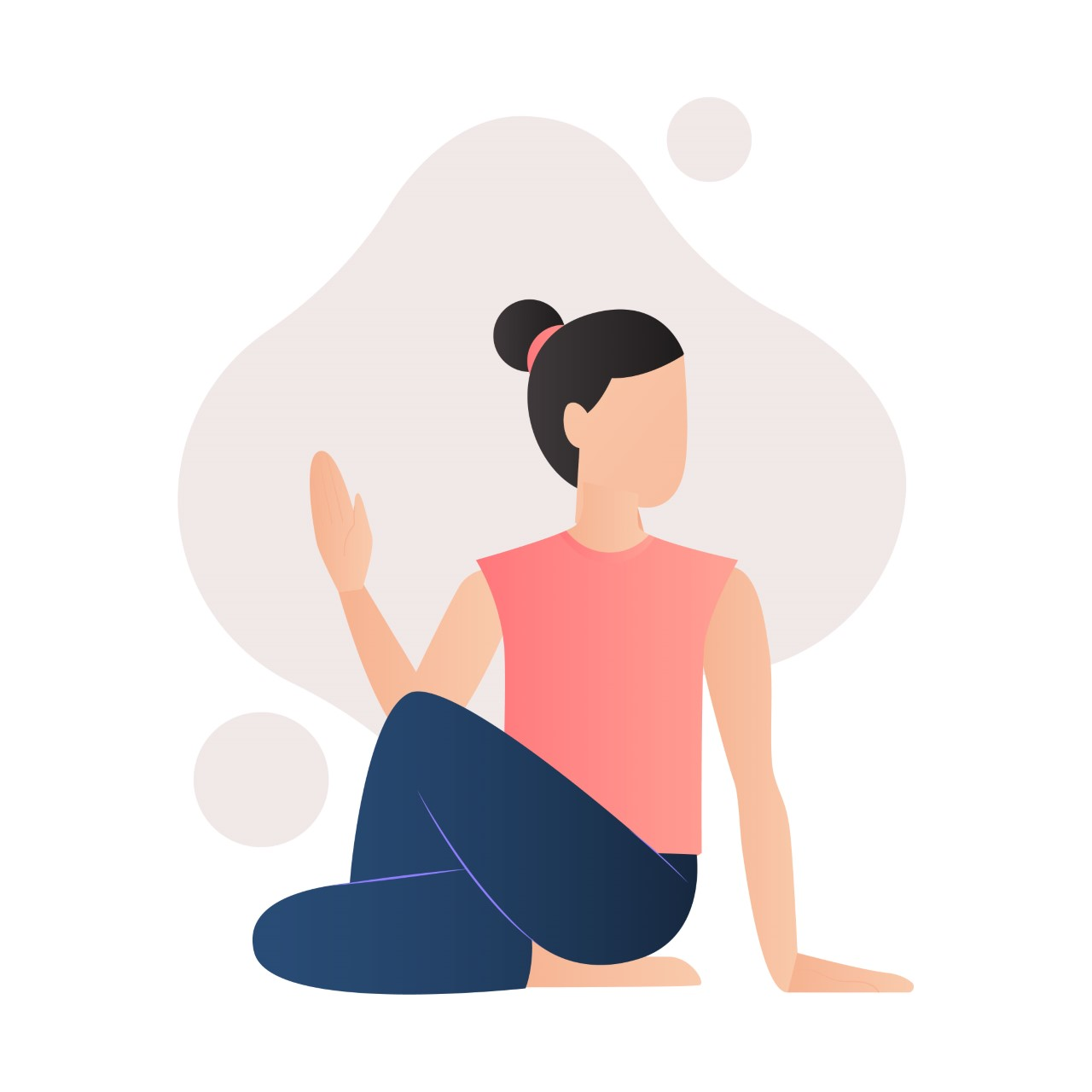
How to do seated twist exercise?
-
Sit on the floor with your legs crossed in front of you.
-
Place your left hand on your right knee, and your right hand on the floor behind your right hip.
-
Inhale and sit up tall, lengthening your spine.
-
As you exhale, twist your torso to the right, using your left hand to gently push against your right knee to deepen the stretch.
-
Hold for a few breaths, then inhale and come back to the centre.
-
Repeat on the other side, placing your right hand on your left knee and your left hand on the floor behind your left hip.
-
Continue alternating sides for 2-3 sets of 10-15 repetitions.
Precautions: Make sure to keep your spine tall and your breath steady throughout the exercise, and don't push too hard into the twist if it feels uncomfortable.
In the video below, Mr. Arun Sagar, Physical Therapist, Manipal Hospitals, Old Airport Road demonstrates basic exercises you can do at home to maintain health and fitness.
Frequency and Duration of Posture Correction Exercises
Improving your posture takes time and effort, so it's important to be consistent with your exercise routine. The recommended frequency set by the best spine care hospital in Bangalore and duration of exercises can vary depending on what works best for you, but it's generally suggested to do them 2-3 times per week for optimal results.
Don't get discouraged if you don't see results immediately. Stick with your exercise routine and remember that every little bit helps. By making these healthy habits a part of your daily routine, you can improve your posture and reduce your risk of pain and injury in the long term.
Important Lifestyle Changes to Correct Your Posture
In addition to doing posture correction exercises, there are several lifestyle changes you can make to improve your posture:
-
Sit less
-
Improve your workstation.
-
Use ergonomic accessories.
-
Practise good posture while sleeping.
-
Wear comfortable shoes.
-
Exercise regularly.
FAQ's
Yes, regular exercise can help correct posture. The exercises that strengthen the core, upper back, and shoulders can improve posture. Exercises that stretch tight muscles in the chest and improve spinal mobility are also helpful
There are many exercises that can be done at home and at the gym, such as planks, shoulder blade squeezes, and glute bridges to correct bad postures.
Yes, years of bad posture can be improved with consistent effort. So, while it might take time, there's a good chance you can see improvement on your posture even if it's been bad for years.
Here are some tips to fix your posture that can be done daily:
-
Be mindful of your posture throughout the day: This includes sitting up straight, avoiding slouching, and keeping your shoulders relaxed.
-
Make small changes to your workstation: Ensure your chair and desk are at an appropriate height for you to sit comfortably with good back support.
-
Take breaks from sitting: Get up and move around every 30 minutes or so to avoid tightness and stiffness.
There is no single exercise that is best for correcting postures. A variety of beneficial exercises including planks, shoulder blade squeezes, chin tucks, chest stretches, cat-cow stretches, glute bridges, wall angels, and seated twists. These target different muscle groups that contribute to good posture.






















 7 Min Read
7 Min Read
















